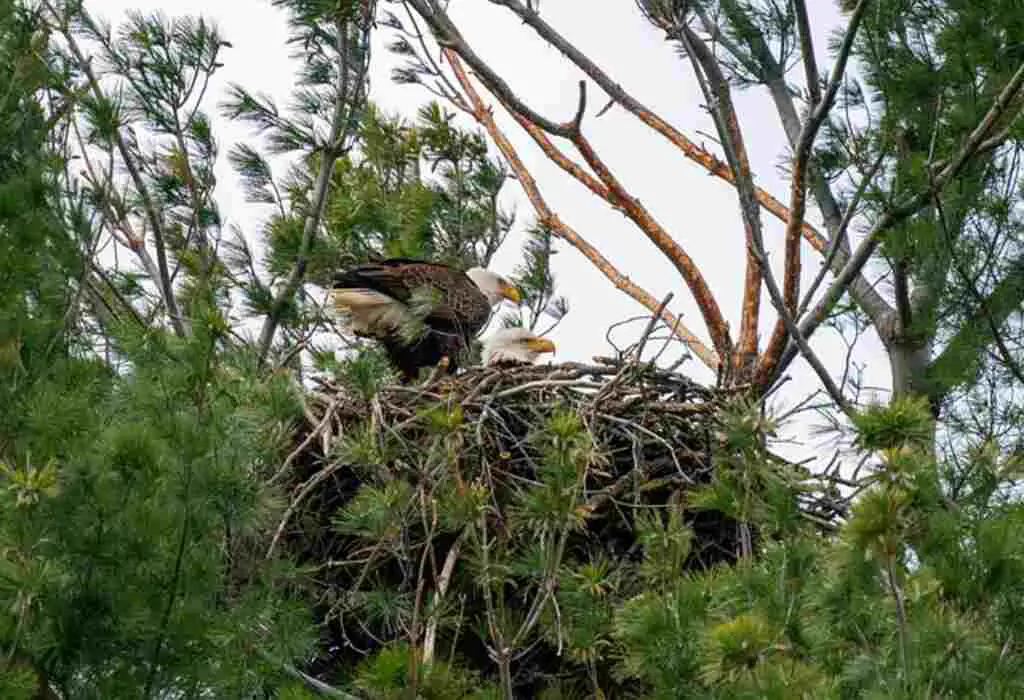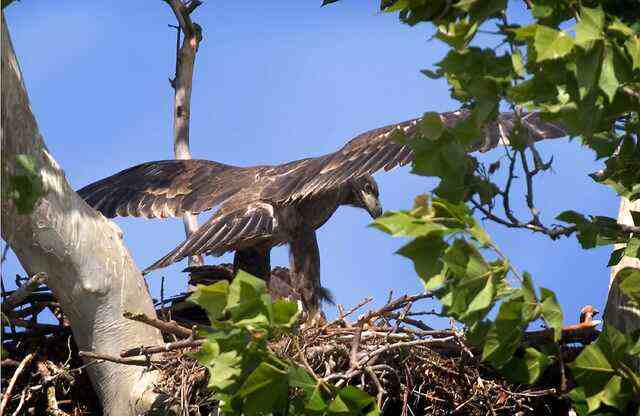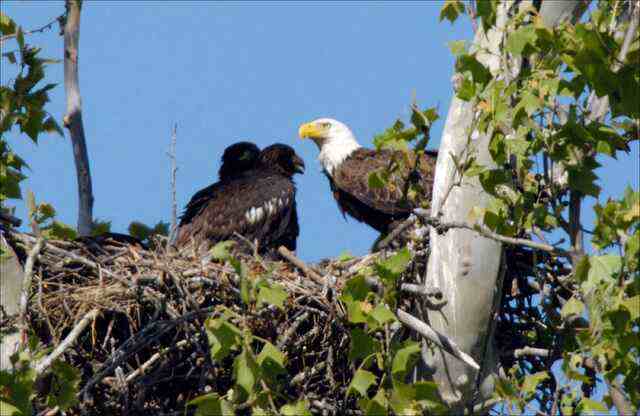Eagles’ nesting behavior is a captivating aspect of their life cycle, intriguing researchers and wildlife enthusiasts alike.
In this article, we delve into the question, “When Do Eagles Return To Their Nest?” and explore the scientific factors influencing their nesting behavior.
From environmental conditions to prey availability, we gain insights into the timing of their nest returns.
Additionally, we discuss the significance of monitoring and conservation efforts in safeguarding eagle populations and nesting sites.
For observers, eagle nesting etiquette is emphasized, and famous nesting sites worldwide are highlighted.
Discover the profound importance of eagle nesting in ecosystems and observe these magnificent birds freely.
Table of Contents
- 1 Key Takeaways
- 2 When Do Eagles Return To Their Nest
- 3 The Life Cycle of Eagles
- 4 Understanding Eagle Nesting Habits
- 5 Factors Influencing Eagle Nesting Behavior
- 6 The Timing of Eagle Nesting
- 7 The Return of Eagles to Their Nests
- 8 The Role of Eagles in Parenting
- 9 Monitoring and Conservation Efforts
- 10 Eagle Nesting Etiquette for Observers
- 11 Famous Eagle Nesting Sites Around the World
- 12 The Importance of Eagle Nesting in Ecosystems
- 13 Frequently Asked Questions
- 14 Conclusion
- 15 Author
Key Takeaways
- Eagles exhibit fidelity to their nest sites and often return to the same nest year after year.
- Eagles synchronize their nesting activities with the changing seasons and the arrival of migratory prey species.
- The nesting season duration varies depending on the species and geographic location of eagles.
- Understanding nesting seasons helps avoid interference during critical phases.
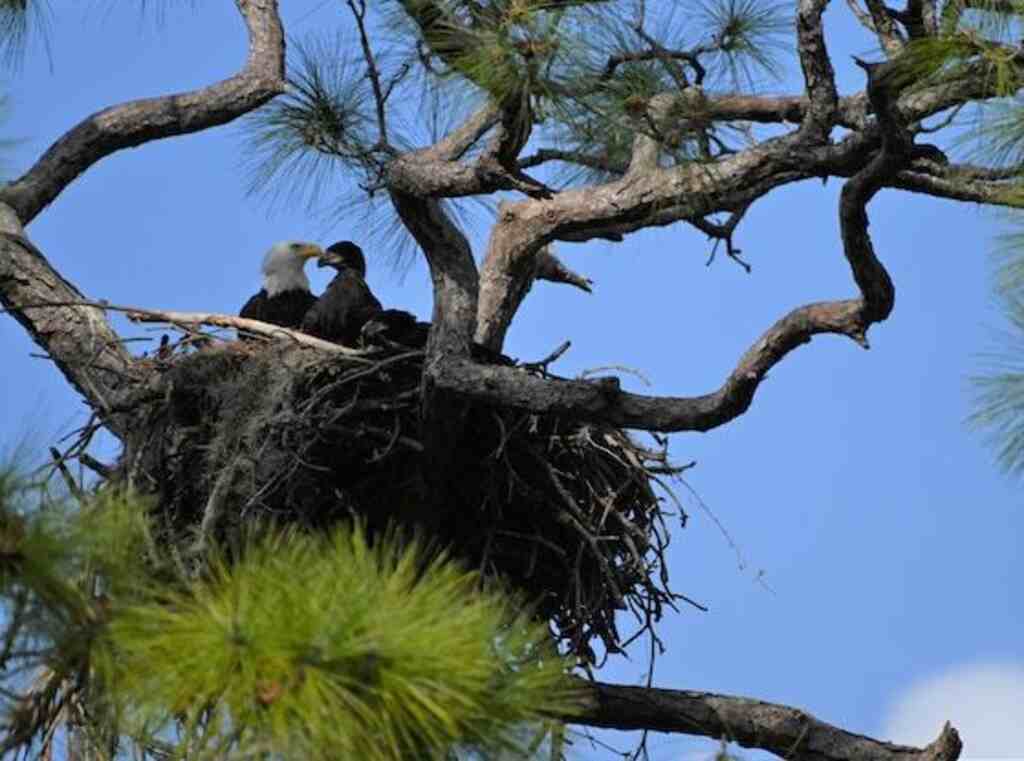
When Do Eagles Return To Their Nest
Eagles typically return to their nests during the breeding season, which varies depending on the species and geographical location. In general, eagles start returning to their nests in late winter or early spring.
They engage in courtship rituals and nest-building activities before laying eggs. The exact timing can differ based on factors like climate, food availability, and local breeding habits.
The Life Cycle of Eagles
The return to their nest is a significant event in the life cycle of eagles. Understanding eagle reproduction and nesting behavior analysis is crucial to comprehend this behavior.
Eagles typically return to their nests during the breeding season, which varies depending on the species and geographical location.
During this time, males and females engage in courtship rituals, including aerial displays and vocalizations, to establish pair bonds.
Once the nest is chosen, both parents contribute to its construction, usually in a high and secluded location, such as a tree or cliff ledge.
The nesting habits of eagles are shaped by their need for security and protection for their eggs and young.
These habits are influenced by various factors, including the availability of suitable nesting sites and the abundance of prey.
Understanding these nesting habits provides valuable insights into the behavior and ecology of eagles.
Transitioning into the subsequent section about understanding eagle nesting habits, it is important to further explore the factors that influence nest site selection and the role of parental care in eagle reproduction.
Understanding Eagle Nesting Habits
Contrary to expectations, the annual cycle of eagle nesting exhibits a remarkable consistency. Eagles display consistent nesting patterns and a predictable nesting season duration.
Eagle nesting patterns typically follow a specific sequence, starting with nest building in early spring, followed by egg-laying, incubation, and finally, fledging of the young.
The nesting season duration varies depending on the specific eagle species and geographic location.
For example, Bald Eagles in North America typically have a nesting season that lasts from February to July, while Golden Eagles in Europe have a slightly shorter nesting season, from March to June.
These nesting patterns are essential for successful reproduction and ensuring the survival of the species.
Factors such as food availability, weather conditions, and habitat quality influence eagle nesting behavior, as explored in the subsequent section.
Factors Influencing Eagle Nesting Behavior
Factors such as food availability, weather conditions, and habitat quality play a significant role in shaping eagle nesting behavior.
Understanding nesting behavior is crucial in order to comprehend how environmental factors influence the timing and success of eagle nesting.
Several key factors have been identified that affect eagle nesting behavior:
- Food availability: Eagles require an ample supply of prey, such as fish or small mammals, in order to successfully raise their young. Areas with abundant food sources are more likely to attract nesting eagles.
- Weather conditions: Eagles are sensitive to extreme weather events, such as storms or prolonged periods of cold temperatures. Unfavorable weather conditions can disrupt nesting activities and negatively impact the survival of eggs or young eagles.
- Habitat quality: Eagles prefer nesting in areas with tall, sturdy trees located near bodies of water. The availability of suitable nesting trees and the overall condition of the surrounding habitat influence the selection of nesting sites.
- Human disturbance: Eagles are sensitive to human activities, and excessive disturbance near their nests can lead to nest abandonment or decreased reproductive success.
Understanding these environmental factors provides valuable insights into the nesting behavior of eagles.
Transitioning into the subsequent section about the timing of eagle nesting, it is important to explore when eagles return to their nests and initiate breeding activities.
The Timing of Eagle Nesting
During the breeding season, eagles synchronize their nesting activities with the changing seasons, ensuring the arrival of suitable conditions for successful reproduction.
Eagle nesting patterns are influenced by various environmental factors, including food availability, weather conditions, and daylight hours.
Eagles typically begin nesting in late winter or early spring, when food sources start to become more abundant.
The timing of nesting also coincides with the arrival of migratory prey species, such as fish and waterfowl, which provide a vital food source for eagles and their young.
Additionally, eagles prefer to nest in areas with minimal human disturbance, such as remote forests or cliffs, further influencing their nesting timing.
This synchronization of nesting activities with environmental factors maximizes the chances of successful reproduction and ensures the survival of the eagle population.
The return of eagles to their nests is a critical step in their breeding cycle, marking the beginning of the next phase of their reproductive journey.
The Return of Eagles to Their Nests
In preparation for the next phase of their reproductive journey, eagles make their way back to the safety and familiarity of their nests.
Eagle nesting behaviors and patterns play a crucial role in determining when eagles return to their nests.
The timing of their return is influenced by various factors, including geographic location, climate, and availability of food.
Generally, eagles return to their nests during the breeding season, which typically occurs in the early spring.
They exhibit a strong fidelity to their nest sites, often returning to the same nest year after year. This behavior ensures that the nest is well-established and maintained for successful breeding.
The return of eagles to their nests marks the beginning of their parenting responsibilities, as they prepare for the arrival of their offspring.
Transitioning to the subsequent section about ‘the role of eagles in parenting,’ eagles’ return to their nests initiates their critical role in raising their young.
The Role of Eagles in Parenting
The return of eagles to their nests explored the fascinating phenomenon of when eagles return to their nests. Now, let us delve into the intriguing topic of the role of eagles in parenting.
Eagles are known for their exceptional parenting skills, and both the male and female play vital roles in raising their offspring.
The male eagle is responsible for hunting and providing food for the family, while the female takes charge of incubating the eggs and protecting the nest.
Once the eggs hatch, both parents take turns feeding and caring for the eaglets.
Eagle parenting techniques include teaching the young ones how to fly, hunt, and survive in their environment.
This comprehensive approach ensures the survival and development of their offspring.
Understanding the role of fathers and the intricate eagle parenting techniques provides valuable insights into their unique family dynamics.
Transitioning to the subsequent section about monitoring and conservation efforts, it is crucial to recognize the significance of these parenting behaviors in the context of protecting and preserving eagle populations worldwide.

Monitoring and Conservation Efforts
To ensure the preservation of eagle populations worldwide, it is imperative to closely monitor their behaviors and implement effective conservation strategies.
Monitoring techniques play a crucial role in understanding eagle nesting behaviors and population dynamics.
Researchers use various methods such as satellite tracking, radio telemetry, and visual surveys to collect data on eagle movement patterns, habitat preferences, and nesting activities.
These techniques provide valuable insights into their foraging habits, migration routes, and breeding success.
Additionally, habitat preservation is essential for the long-term survival of eagles.
By protecting their nesting sites and ensuring the availability of suitable habitats, we can create conducive environments for eagle populations to thrive.
Conservation efforts should focus on minimizing disturbances to nesting areas and promoting sustainable land management practices.
Observing eagle nesting etiquette is essential for minimizing human impact on these majestic birds and their fragile habitats, ensuring their continued existence.
Eagle Nesting Etiquette for Observers
When observing eagles nesting, it is important to respect the distance between the observer and the wildlife.
Maintaining a safe distance helps to minimize disturbance and reduce the potential impact on the nesting eagles.
By following proper eagle nesting etiquette, observers can contribute to the conservation efforts and ensure the welfare of these majestic birds.
Respecting Distance and Wildlife
Respecting the need for distance between humans and wildlife is crucial in order to maintain the natural behaviors and habitats of animals, such as eagles returning to their nests.
When observing eagles in their nesting areas, it is important to follow ethical guidelines to ensure wildlife preservation and minimize disturbance. Here are three key points to consider:
- Keep a safe distance: Maintaining a respectful distance from the nest allows the eagles to feel secure and prevents unnecessary stress or disturbance.
- Use ethical photography practices: Avoid using flash photography or making loud noises that could startle the eagles. Respect their space and minimize any potential impact on their behavior.
- Be aware of nesting seasons: Understanding the nesting seasons of eagles helps avoid unnecessary interference during critical phases, such as egg-laying or chick-rearing.
By adhering to these guidelines, observers can enjoy the beauty of eagles returning to their nests while minimizing disturbance and impact on the wildlife.
Minimizing Disturbance and Impact
Maintaining a respectful distance from eagle nesting areas helps to ensure the preservation of wildlife behaviors and habitats.
Minimizing human disturbance is crucial for protecting nesting habitats and minimizing the impact on eagle populations.
By minimizing disturbance, we can reduce stress on the birds and their young, allowing them to carry out their natural behaviors without interference.
This includes avoiding loud noises, sudden movements, and getting too close to the nests.
To illustrate the importance of minimizing disturbance, the following table provides a visual representation of the potential impacts of human activities on eagle nesting areas:
| Human Activities | Impact on Eagles and Nests |
|---|---|
| Noise pollution | Disturbs nesting behavior |
| Habitat destruction | Reduces available nesting sites |
| Pollution | Harms eagle health and reproduction |
| Human presence | Causes stress and abandonment of nests |
| Nest disturbance | Increases risk of nest failure |
By minimizing human disturbance and protecting nesting habitats, we can help ensure the survival and success of eagle populations. Transitioning to the subsequent section, let us explore famous eagle nesting sites around the world.
Famous Eagle Nesting Sites Around the World
Two famous eagle nesting sites around the world are the Bald Eagles in Alaska’s Chilkat Valley and the Golden Eagles in Scotland’s Cairngorms National Park.
The Chilkat Valley is known as the world’s largest concentration of Bald Eagles during their winter migration.
This area provides a rich feeding ground for the eagles due to the availability of salmon in the Chilkat River.
On the other hand, Scotland’s Cairngorms National Park is home to a significant population of Golden Eagles, which are known for their majestic appearance and impressive hunting skills.
Bald Eagles in Alaska’s Chilkat Valley
Bald Eagles in Alaska’s Chilkat Valley return to their nests during the springtime. This region serves as an ideal habitat for these majestic birds due to its abundant food sources and suitable nesting locations.
Bald eagles exhibit fascinating nesting behavior, constructing large nests made of sticks and twigs, often located high in trees near bodies of water.
The nests are built year after year, with the same pair of eagles often returning to the same nest site.
During the breeding season, eagles engage in elaborate courtship displays, where they perform aerial acrobatics and vocalize to attract a mate.
The Chilkat Valley provides a pristine environment for bald eagles, offering ample prey such as fish and small mammals.
Transitioning to the subsequent section about golden eagles in Scotland’s Cairngorms National Park, these magnificent birds exhibit similar nesting behaviors but in a different geographical context.
Golden Eagles in Scotland’s Cairngorms National Park
Golden eagles, found in Scotland’s Cairngorms National Park, actively construct their nests using a variety of materials and strategically position them within the rugged landscape for optimal hunting opportunities.
These nests, also known as eyries, are typically built on high cliffs or rocky outcrops, providing the eagles with a commanding view of their surroundings.
The eagle population in the Cairngorms National Park has been monitored for many years, and studies have shown that the nesting success of golden eagles is closely linked to habitat quality and prey availability.
Factors such as habitat degradation, loss of prey species, and disturbance from human activities can negatively impact nesting success.
Understanding the nesting behavior and success of golden eagles is crucial for their conservation and the overall health of ecosystems.
This knowledge provides valuable insights into the management and protection of eagle populations in the park, ensuring their continued presence for future generations.
Transitioning to the subsequent section about ‘the importance of eagle nesting in ecosystems’, it is evident that the nesting behavior of golden eagles plays a significant role in maintaining the ecological balance.
The Importance of Eagle Nesting in Ecosystems
The nesting behavior of eagles plays a crucial role in maintaining the balance and diversity of ecosystems, as their nests provide shelter and resources for a wide array of organisms, creating a bustling hub of activity and vitality.
The ecological benefits of eagle nesting are manifold.
Firstly, their nests act as a safe haven for other bird species, who often build their own nests nearby, benefiting from the protection provided by the eagles’ presence.
Secondly, the remains of prey brought to the nest by the eagles serve as a valuable source of food for scavengers such as ravens and foxes.
Lastly, the large sticks and branches used in constructing eagle nests create microhabitats for a variety of invertebrates, further enhancing the overall biodiversity of the area.
Unfortunately, human disturbance can have a significant impact on eagle nesting.
Activities such as logging, construction, and recreational use of the surrounding areas can disrupt nesting sites, leading to abandonment or reduced nesting success.
It is therefore crucial to implement conservation measures to protect these vital habitats and ensure the continued ecological benefits of eagle nesting.
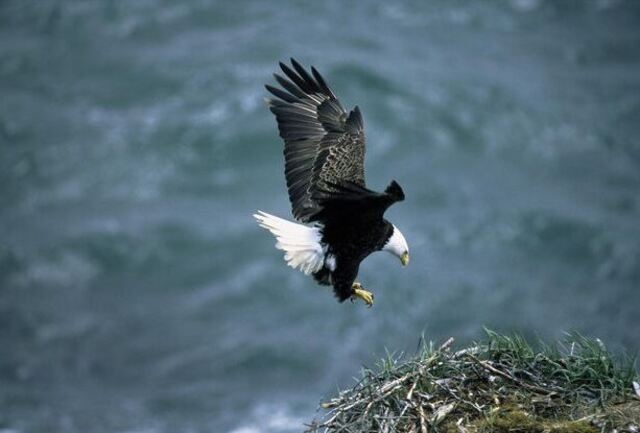
Frequently Asked Questions
How long does it take for an eagle egg to hatch?
The development of an eagle egg, also known as the incubation period, can vary depending on the species. On average, it takes around 35 to 45 days for an eagle egg to hatch.
Do eagles reuse their nests every year?
Eagles exhibit remarkable nest maintenance and construction behaviors. They invest considerable effort in building and repairing their nests each year, showcasing their dedication to providing a safe and comfortable habitat for their offspring.
How far do eagles typically travel during migration?
Eagles typically travel long distances during migration, with some species covering up to thousands of miles. Their migration patterns vary depending on factors such as food availability, weather conditions, and breeding requirements.
What are some common threats to eagle nests?
Common threats to eagle nests include predation and habitat loss. Predation poses a risk to the survival of eagle offspring, while habitat loss reduces the availability of suitable nesting sites, impacting the overall population.
How long do eagles stay with their young before they leave the nest?
Eagle parenting involves a period of nurturing and care for their young before nest abandonment. The duration of this period varies among eagle species, typically ranging from several months to around 12 weeks.
Conclusion
In conclusion, understanding the nesting habits of eagles is crucial for conservation efforts and maintaining the balance of ecosystems. The timing of eagle nesting is influenced by various factors, such as weather conditions and food availability.
Monitoring and conservation efforts play a significant role in protecting these majestic birds and their nests. By respecting eagle nesting etiquette, observers can contribute to the preservation of these magnificent creatures.
Famous eagle nesting sites around the world serve as important hubs for research and education. The return of eagles to their nests is a remarkable event that showcases the resilience and adaptability of these fascinating birds.
Through continued study and conservation efforts, we can ensure the survival and thriving of eagle populations for generations to come.

